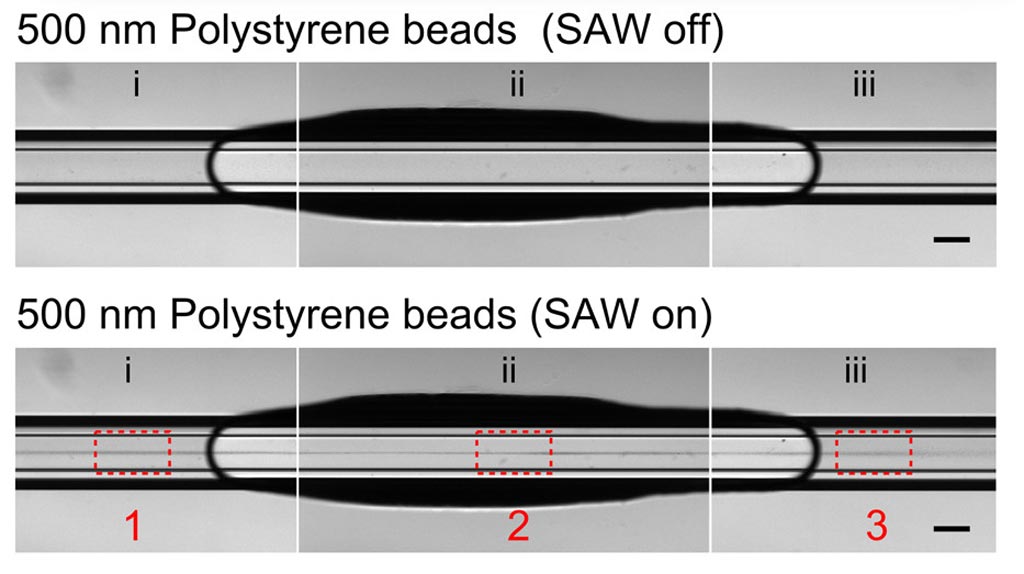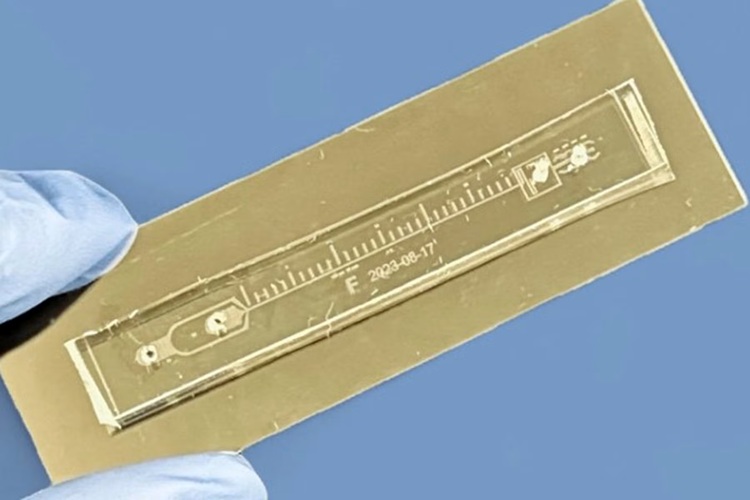Immunoassay Device Based on Acoustic Vortex Nanoparticle Enrichment
|
By LabMedica International staff writers Posted on 08 Feb 2017 |

Image: A sample of 500 nanometer particles in solution. In the top image, the acoustic whirlpool device was turned off. The bottom image shows that when the device was turned on, the nanoparticles were concentrated to the point of becoming visible as a dark line down the center of the chamber (Photo courtesy of Duke University).
An inexpensive acoustic transducer is the key to a novel immunoassay that may eventually be combined with a smartphone camera to form a platform for the rapid detection of diagnostic proteins in blood, urine, or saliva samples.
Investigators at Duke University developed an acoustic-fluidic chip capable of generating single vortex acoustic streaming inside a glass capillary through using low-power acoustic waves (only five volts was required). The single vortex acoustic streaming that was generated, in conjunction with the acoustic radiation force, was able to enrich submicrometer- and nanometer-sized particles in a small volume. Numerical simulations were used to clarify the mechanism of the single vortex formation and were verified experimentally, demonstrating the focusing of silica and polystyrene particles ranging in diameter from 80 to 500 nanometers.
In a proof-of-principle study, the acoustic-fluidic chip was used to perform an immunoassay in which nanoparticles that captured fluorescently labeled biomarkers were concentrated in a long, thin glass vial to enhance the emitted signal.
“Diagnosis impacts about 70% of healthcare decisions,” said senior author Dr. Tony Huang, professor of mechanical engineering and materials science at Duke University. “If we can improve the quality of diagnostics while reducing its costs, then we can tremendously improve the entire healthcare system. My goal is to create a small diagnostic device about the size of a cell phone that can autonomously separate biomarkers from samples. With this vortex technology, the biomarkers could then be concentrated enough to see with a simple camera like the ones found in today’s cellular phones.”
Investigators at Duke University developed an acoustic-fluidic chip capable of generating single vortex acoustic streaming inside a glass capillary through using low-power acoustic waves (only five volts was required). The single vortex acoustic streaming that was generated, in conjunction with the acoustic radiation force, was able to enrich submicrometer- and nanometer-sized particles in a small volume. Numerical simulations were used to clarify the mechanism of the single vortex formation and were verified experimentally, demonstrating the focusing of silica and polystyrene particles ranging in diameter from 80 to 500 nanometers.
In a proof-of-principle study, the acoustic-fluidic chip was used to perform an immunoassay in which nanoparticles that captured fluorescently labeled biomarkers were concentrated in a long, thin glass vial to enhance the emitted signal.
“Diagnosis impacts about 70% of healthcare decisions,” said senior author Dr. Tony Huang, professor of mechanical engineering and materials science at Duke University. “If we can improve the quality of diagnostics while reducing its costs, then we can tremendously improve the entire healthcare system. My goal is to create a small diagnostic device about the size of a cell phone that can autonomously separate biomarkers from samples. With this vortex technology, the biomarkers could then be concentrated enough to see with a simple camera like the ones found in today’s cellular phones.”
Latest Technology News
- AI Saliva Sensor Enables Early Detection of Head and Neck Cancer
- AI-Powered Biosensor Technology to Enable Breath Test for Lung Cancer Detection
- AI Model Achieves Breakthrough Accuracy in Ovarian Cancer Detection
- Portable Biosensor Diagnoses Psychiatric Disorders Using Saliva Samples
- Cell-Sorting Device Uses Electromagnetic Levitation to Precisely Direct Cell Movement

- Embedded GPU Platform Enables Rapid Blood Profiling for POC Diagnostics
- Viral Biosensor Test Simultaneously Detects Hepatitis and HIV
- Acoustofluidic Device to Transform Point-Of-Care sEV-Based Diagnostics
- AI Algorithm Assesses Progressive Decline in Kidney Function
- Taste-Based Influenza Test Could Replace Nasal Swabs with Chewing Gum
- 3D Micro-Printed Sensors to Advance On-Chip Biosensing for Early Disease Detection
Channels
Clinical Chemistry
view channel
Chemical Imaging Probe Could Track and Treat Prostate Cancer
Prostate cancer remains a leading cause of illness and death among men, with many patients eventually developing resistance to standard hormone-blocking therapies. These drugs often lose effectiveness... Read more
Mismatch Between Two Common Kidney Function Tests Indicates Serious Health Problems
Creatinine has long been the standard for measuring kidney filtration, while cystatin C — a protein produced by all human cells — has been recommended as a complementary marker because it is influenced... Read moreMolecular Diagnostics
view channel
New Genetic Test Enables Faster Diagnosis of Rare Diseases
Rare disease diagnosis often involves a long and uncertain search for the underlying genetic cause. Traditional testing requires multiple separate analyses, although many patients remain without answers.... Read more
Urine Test Detects Inherited Neuropathy Missed by Genetic Screening
Sorbitol dehydrogenase (SORD)-related neuropathy is one of the most common inherited nerve disorders, yet diagnosis often lags because current genetic screens frequently miss the causal gene.... Read moreHematology
view channel
Platelet Activity Blood Test in Middle Age Could Identify Early Alzheimer’s Risk
Early detection of Alzheimer’s disease remains one of the biggest unmet needs in neurology, particularly because the biological changes underlying the disorder begin decades before memory symptoms appear.... Read more
Microvesicles Measurement Could Detect Vascular Injury in Sickle Cell Disease Patients
Assessing disease severity in sickle cell disease (SCD) remains challenging, especially when trying to predict hemolysis, vascular injury, and risk of complications such as vaso-occlusive crises.... Read more
ADLM’s New Coagulation Testing Guidance to Improve Care for Patients on Blood Thinners
Direct oral anticoagulants (DOACs) are one of the most common types of blood thinners. Patients take them to prevent a host of complications that could arise from blood clotting, including stroke, deep... Read moreImmunology
view channel
Chip Captures Cancer Cells from Blood to Help Select Right Breast Cancer Treatment
Ductal carcinoma in situ (DCIS) accounts for about a quarter of all breast cancer cases and generally carries a good prognosis. This non-invasive form of the disease may or may not become life-threatening.... Read more
Blood-Based Liquid Biopsy Model Analyzes Immunotherapy Effectiveness
Immunotherapy has revolutionized cancer care by harnessing the immune system to fight tumors, yet predicting who will benefit remains a major challenge. Many patients undergo costly and taxing treatment... Read moreMicrobiology
view channel
Rapid Assay Identifies Bloodstream Infection Pathogens Directly from Patient Samples
Bloodstream infections in sepsis progress quickly and demand rapid, precise diagnosis. Current blood-culture methods often take one to five days to identify the pathogen, leaving clinicians to treat blindly... Read more
Blood-Based Molecular Signatures to Enable Rapid EPTB Diagnosis
Extrapulmonary tuberculosis (EPTB) remains difficult to diagnose and treat because it spreads beyond the lungs and lacks easily accessible biomarkers. Despite TB infecting 10 million people yearly, the... Read more
15-Minute Blood Test Diagnoses Life-Threatening Infections in Children
Distinguishing minor childhood illnesses from potentially life-threatening infections such as sepsis or meningitis remains a major challenge in emergency care. Traditional tests can take hours, leaving... Read more
High-Throughput Enteric Panels Detect Multiple GI Bacterial Infections from Single Stool Swab Sample
Gastrointestinal (GI) infections are among the most common causes of illness worldwide, leading to over 1.7 million deaths annually and placing a heavy burden on healthcare systems. Conventional diagnostic... Read morePathology
view channel
Blood Test and Sputum Analysis Predict Acute COPD Exacerbation
Chronic obstructive pulmonary disease (COPD) remains a major contributor to global illness, largely driven by cigarette smoking and marked by irreversible lung damage. Acute exacerbations can accelerate... Read more
AI Tool to Transform Skin Cancer Detection with Near-Perfect Accuracy
Melanoma continues to be one of the most difficult skin cancers to diagnose because it often resembles harmless moles or benign lesions. Traditional AI tools depend heavily on dermoscopic images alone,... Read more
Unique Immune Signatures Distinguish Rare Autoimmune Condition from Multiple Sclerosis
Myelin oligodendrocyte glycoprotein antibody–associated disease (MOGAD) is a rare autoimmune disorder in which the immune system attacks the myelin sheath in the central nervous system. Although symptoms... Read moreIndustry
view channel
Abbott Acquires Cancer-Screening Company Exact Sciences
Abbott (Abbott Park, IL, USA) has entered into a definitive agreement to acquire Exact Sciences (Madison, WI, USA), enabling it to enter and lead in fast-growing cancer diagnostics segments.... Read more








 assay.jpg)













